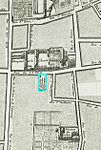Saint-Germain Cemetery

The Saint-Germain Cemetery (cimetière Saint-Germain) or Saint-Pierre Cemetery (cimetière Saint-Pierre) was a rectangular cemetery in Paris, first attested in 1259 (1259) and used by Protestants from 1598 to 1604 onwards. It was sited in the north-west corner of the former rue Taranne and rue des Saints-Pères, alongside the chapelle des Saint-Pères (on the site now occupied by square de la Charité at 186 boulevard Saint-Germain. It measured 27 toise by 8 toise (54 by 16 m (177 by 52 ft)). Its site is now covered by Square Taras-Chevtchenko. Owned by the parish of Saint-Sulpice, it was used for plague victims and lepers until 1544. Article 45 of the Edict of Nantes noted it as one of two Protestant cemeteries in Paris (the other was La Trinité Cemetery). The parish council required them to leave it in 1604 and they moved to the nearby Saints-Pères Cemetery. The Hôpital de la Charité briefly used the cemetery from 1604 to 1609.
Excerpt from the Wikipedia article Saint-Germain Cemetery (License: CC BY-SA 3.0, Authors, Images).Saint-Germain Cemetery
Rue des Saints-Pères, Paris Quartier de Saint-Germain-des-Prés (Paris)
Geographical coordinates (GPS) Address Website Nearby Places Show on map
Geographical coordinates (GPS)
| Latitude | Longitude |
|---|---|
| N 48.855277777778 ° | E 2.3308333333333 ° |
Address
Université de Paris
Rue des Saints-Pères 45
75006 Paris, Quartier de Saint-Germain-des-Prés (Paris)
Ile-de-France, France
Open on Google Maps








